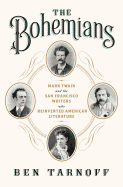
San Francisco in the 1860s was home to what Ben Tarnoff (A Counterfeiter's Paradise) calls " an extraordinary literary scene." The Bohemians is an entertaining, engaging foray into U.S. literary history, with Mark Twain at the head of the pack, closely followed by Bret Harte and the poets Charles Warren Stoddard and Ina Coldbrith. While the Eastern old guard was genteel, moralistic and grandiose, the western Bohemians were ironic and irreverent. They belonged to Bohemia "because they didn't belong anywhere else."
San Francisco, urban and rural, crude yet cultured, with its unmistakably western atmosphere and its thriving publishing tradition, became their perfect home--at least for a while. Twain was an aspiring journalist when he arrived at his "city of startling events" in 1864. Three years later, he published "The Jumping Frog of Calavaras County," with The Innocents Abroad following two years after that. Then he moved back east. Similarly, Harte, the soft-spoken dandy, arrived in San Francisco in 1860, published his breakthough piece, "The Luck of Roaring Camp," and left in 1871.
Stoddard, the gay bookstore clerk whom Jack London called the "Love Man," became co-editor of the Overland Monthly, a welcoming home for all the literary Bohemians. His colleague Coldbrith, by far the most active in the city's literary scene, became California's poet laureate and librarian of the city's famous Bohemian Club. Together, they created a new American literature. --Tom Lavoie, former publisher

